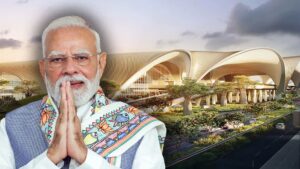Mumbai – Prime Minister Narendra Modi inaugurated two landmark Mumbai infrastructure projects worth nearly $4 billion on Wednesday, marking another significant milestone in his administration’s ambitious effort to modernize infrastructure in the world’s most populous country. The seaside metropolis, which serves as India’s financial capital, is undergoing a comprehensive overhaul of its decades-old infrastructure systems.
Modi emphasized that these new connectivity projects will strengthen Mumbai’s position as a global hub of growth and opportunity, stating that “India is investing in infrastructure aimed at improving ease of living in India.”
Navi Mumbai International Airport: A New Aviation Hub

The centerpiece of the Mumbai infrastructure projects is the new Navi Mumbai International Airport, which Modi toured alongside billionaire Gautam Adani and his son Jeet. The Adani Group has developed this greenfield airport project, which represents a significant addition to the region’s aviation capacity.
Built to resemble a lotus—India’s national flower—the airport will span over 1,160 hectares in Navi Mumbai, a satellite city east of Mumbai. The facility is designed to eventually handle 90 million passengers per year over time and will be India’s first airport to be connected by a water taxi, adding a unique dimension to passenger transportation.
Addressing Aviation Bottlenecks
The new terminal is expected to significantly ease aviation bottlenecks at Mumbai’s sole existing airport, which is already hemmed in with slum clusters on one side. The Mumbai infrastructure projects aim to address these capacity constraints while boosting real estate development in the surrounding Navi Mumbai area.
Sheldon Hee, regional vice president Asia-Pacific at International Air Transport Association, stated that the new airport “will ease the capacity constraints in the Mumbai region” and strengthen connectivity. IATA plans to collaborate with the Navi Mumbai airport team “to deliver the required capacity efficiently, foster innovation and create a seamless experience for passengers and stakeholders.”
Phased Development and Investment

Commercial flight operations are expected to begin in December, according to Adani Airport Holdings Ltd.’s Chief Executive Arun Bansal, who spoke at a press briefing on Monday. Initially, the airport will have the capacity to handle 20 million passengers every year. The Adani Group plans to invest another 300 billion rupees in the second phase of airport development.
Also Read: PM Modi Mumbai Visit: Big Infrastructure Inaugurations and Starmer Meeting
The Adani Group is developing the airport through a special purpose vehicle, Navi Mumbai International Airport Pvt, in which the conglomerate’s airport unit holds a majority stake of 74 percent. The state-owned City and Industrial Development Corporation of Maharashtra Ltd. holds the remaining 26 percent stake.
Metro-3 Aqua Line: Underground Transit Revolution
Another crucial component of the Mumbai infrastructure projects is the completion of the final phase of Metro-3, known as the Aqua Line. This represents the city’s first underground metro line and marks a revolutionary step in Mumbai’s public transportation evolution.
The underground metro line will connect the city’s southern peninsula to the northern suburbs and offer access to the existing airport, significantly alleviating severe overcrowding on the rail system and congested streets that have long plagued the metropolis.
Strategic Connectivity and Future Integration
The Aqua Line will connect to the Bandra Kurla Complex, the city’s major business district, where construction has already started on the terminus for India’s first high-speed rail. This bullet train will eventually connect Mumbai to Ahmedabad, the largest city in Modi’s home state of Gujarat, creating a seamless high-speed rail corridor.
The metro system is being financed by several international development institutions, including The Asian Development Bank, the Japan International Cooperative Agency, and the Asian Infrastructure Investment Bank, demonstrating global confidence in these Mumbai infrastructure projects.
Broader Infrastructure Investment Wave

These projects are part of a broader wave as billions of dollars flow into India’s logistics and infrastructure initiatives. Federal and state government spending is on the rise, with assets in infrastructure investment trusts—which allow individuals to invest in projects—expected to surge in the coming years.
Government budgetary support for infrastructure has been booming, reflecting the administration’s commitment to modernizing the country’s transportation networks and public systems. The Mumbai infrastructure projects exemplify this nationwide push toward enhanced connectivity and modern facilities.
Addressing Urban Challenges
Despite these significant investments, India still faces a large funding gap and a rapidly growing urban population that risks overwhelming already strained public systems. The administration is taking proactive steps to address these challenges, including rolling out a government program last month aimed at attracting long-term investors like pension funds and life insurance companies.
Transforming the Financial Hub
The Mumbai infrastructure projects represent a comprehensive effort to transform India’s financial capital into a world-class metropolitan center. By addressing both aviation capacity constraints and urban transit challenges simultaneously, these initiatives aim to position Mumbai competitively on the global stage.
The new airport and underground metro line under Mumbai infrastructure projects together promise to enhance the ease of living for millions of residents while supporting economic growth and development. As commercial operations begin and the metro line becomes fully operational, Mumbai’s infrastructure landscape will be fundamentally transformed, supporting the city’s role as India’s commercial and financial powerhouse.
These Mumbai infrastructure projects demonstrate the scale and ambition of India’s modernization drive, setting a precedent for urban development across the country’s rapidly growing cities.

